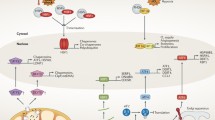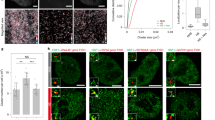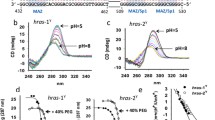Abstract
The heterogeneous nuclear ribonucleoproteins (hnRNPs) constitute an important group of RNA-binding proteins (RBPs) that play an active role in post-transcriptional gene regulation. Here, we focus on representative members of the hnRNP group of RBPs, namely hnRNP A1 and hnRNP C1/C2, which participate mainly in RNA splicing, as well as on HuR, a prototype of the AU-rich element-binding proteins (ARE-BP), which has an established role in regulating the stability and translation of target mRNAs. HuR and most hnRNPs are primarily localized in the nucleoplasm, and they can shuttle between the nucleus and the cytoplasm. Herein, we have extended our recently reported findings on the ability of HuR to associate with the immunopurified from mammalian cell extracts hnRNP and mRNP complexes by the application of an anti-HuR antibody that selects HuR–RNP complexes. We find that the protein components precipitated by the anti-HuR antibody are very similar to the hnRNP-HuR complexes reported previously. The in vivo association of HuR and hnRNP proteins is examined in the presence and the absence of thermal stress by confocal microscopy of intact cells and by in situ nuclear matrix preparation. We find notable heat-induced changes of HuR and of hnRNP A1, which exit the nucleus and co-localize to large cytoplasmic foci that represent heat-induced stress granules. The functional implications of HuR–hnRNP interactions in stressed and unstressed cells are discussed.




Similar content being viewed by others
Abbreviations
- RNP:
-
Ribonucleoprotein
- hnRNP:
-
Heterogeneous nuclear ribonucleoprotein
- RBP:
-
RNA-binding protein
- RRM:
-
RNA recognition motif
- RBD:
-
RNA-binding domain
- KH:
-
hnRNP K homology
- RGG:
-
Arg-Gly-Gly
- ARE:
-
Adenosine-uridine-rich element
- AUF1:
-
AU-binding factor 1
- ELAV:
-
Embryonic lethal abnormal vision
- HuR:
-
Human antigen R
- 3′-UTR:
-
3′-Untranslated region
- TIA-1:
-
T cell internal antigen-1
- TIAR:
-
TIA-1-related
- SGs:
-
Stress granules
- PBs:
-
Processing bodies
- TTP:
-
Tristetraprolin
- MNK1/2:
-
Mitogen-activated protein kinase-interacting kinase1/2
- MKK3/6:
-
MAP-kinase kinase 3/6
- NM:
-
Nuclear matrix
References
Glisovic T, Bachorik JL, Yong J, Dreyfuss G (2008) RNA-binding proteins and post-transcriptional gene regulation. FEBS Lett 582:1977–1986
Dreyfuss G, Matunis JM, Pinol-Roma S, Burd GC (1993) hnRNP proteins and the biogenesis of mRNA. Annu Rev Biochem 62:289–321
Burd CG, Dreyfuss G (1994) Conserved structures and diversity of functions of RNA binding proteins. Science 265:615–621
Krecic AM, Swanson MS (1999) hnRNP complexes: composition, structure, and function. Curr Opin Cell Biol 11:363–371
Dreyfuss G, Kim VN, Kataoka N (2002) Messenger-RNA-binding proteins and the messages they carry. Nat Rev Mol Cell Biol 3:195–205
He Y, Smith R (2009) Nuclear functions of heterogeneous nuclear ribonucleoproteins A/B. Cell Mol Life Sci 66:1239–1256
Lothstein L, Arenstorf HP, Chung SY, Walker BW, Wooley JC, LeStourgeon WM (1985) General organization of protein in HeLa 40S nuclear ribonucleoprotein particles. J Cell Biol 100:1570–1581
Fan XC, Steitz JA (1998) Overexpression of HuR, a nuclear-cytoplasmic shuttling protein, increases the in vivo stability of ARE-containing mRNAs. EMBO J 17:3448–3460
Pinol-Roma S, Dreyfuss G (1992) Shuttling of pre-mRNA binding proteins between nucleus and cytoplasm. Nature 355:730–732
Nakielny S, Dreyfuss G (1996) The hnRNP C proteins contain a nuclear retention sequence that can override nuclear export signals. J Cell Biol 134:1365–1373
Han SP, Tang YH, Smith R (2010) Functional diversity of the hnRNPs: past, present and perspectives. Biochem J 430:379–392
Hinman MN, Lou H (2008) Diverse molecular functions of Hu proteins. Cell Mol Life Sci 65:3168–3181
Brennan CM, Steitz JA (2001) HuR and mRNA stability. Cell Mol Life Sci 58:266–277
Lopez de Silanes I, Lal A, Gorospe M (2005) HuR: post-transcriptional paths to malignancy. RNA Biol 2:11–13
Srikantan S, Gorospe M (2012) HuR function in disease. Front Biosci 17:189–205
Shim J, Karin M (2002) The control of mRNA stability in response to extracellular stimuli. Mol Cells 14:323–331
Barreau C, Paillard L, Osborne HB (2005) AU-rich elements and associated factors: are there unifying principles? Nucleic Acids Res 33:7138–7150
Pullmann R, Kim HH, Abdelmohsen K, Lal A, Martindale JI, Yang X, Gorospe M (2007) Analysis of turnover and translation regulatory RNA-binding protein expression through binding to cognate mRNAs. Mol Cell Biol 27:6265–6278
Hamilton BJ, Burns CM, Nichols RC, Rigby WF (1997) Modulation of AUUUA response element binding by heterogeneous nuclear ribonucleoprotein A1 in human T lymphocytes. The roles of cytoplasmic location, transcription, and phosphorylation. J Biol Chem 272:28732–28741
Zhang W, Wagner BJ, Ehrenman K, Schaefer AW, DeMaria CT, Crater D, DeHaven K, Long I, Brewer G (1993) Purification, characterization, and cDNA cloning of an AU-rich element RNA-binding protein AUF1. Mol Cell Biol 13:7652–7665
Zhang T, Delestienne N, Huez G, Kruys V, Gueydan C (2005) Identification of the sequence determinants mediating the nucleo-cytoplasmic shuttling of TIAR and TIA-1 RNA-binding proteins. J Cell Sci 118:5453–5463
Biamonti G, Caceres JF (2009) Cellular stress and RNA splicing. Trends Biochem Sci 34:146–153
Bond U (1988) Heat shock but not other stress inducers leads to the disruption of a sub-set of snRNPs and inhibition of in vitro splicing in HeLa cells. EMBO J 7:3509–3518
von Roretz C, Di Marco S, Mazroui R, Gallouzi I-E (2011) Turnover of AU-rich- containing mRNAs during stress: a matter of survival. RNA 2:336–347
Masuda K, Abdelmohsen K, Gorospe M (2009) RNA-binding proteins implicated in the hypoxic response. J Cell Mol Med 13:2759–2769
Gallouzi I-E, Brennan CM, Stenberg MG, Swanson MS, Eversole A, Maizels N, Steitz JA (2000) HuR binding to cytoplasmic mRNA is perturbed by heat shock. Proc Natl Acad Sci USA 97:3073–3078
Guil S, Long JC, Caceres JF (2006) hnRNP A1 relocalization to the stress granules reflects a role in the stress response. Mol Cell Biol 26:5744–5758
Kedersha N, Anderson P (2002) Stress granules: sites of mRNA triage that regulate mRNA stability and translatability. Biochem Soc Trans 30:963–969
Papadopoulou C, Patrinou-Georgoula M, Guialis A (2010) Extensive association of HuR with hnRNP proteins within immunoselected hnRNP and mRNP complexes. Biochim Biophys Acta 1804:692–703
Dreyfuss G, Choi YD, Adam SA (1984) Characterization of heterogeneous nuclear RNA-protein complexes in vivo with monoclonal antibodies. Mol Cell Biol 4:1104–1114
Siapka S, Patrinou-Georgoula M, Vlachoyiannopoulos PG, Guialis A (2007) Multiple specificities of autoantibodies against hnRNP A/B proteins in systemic rheumatic diseases and hnRNP L as an associated novel autoantigen. Autoimmunity 40:223–233
Oakley B, Kirsch D, Morris R (1980) A simplified ultrasensitive silver stain for detecting proteins in polyacrylamide gels. Anal Biochem 105:361–363
Stenoien DL, Mancini MG, Patel K, Allegretto EA, Smith CL, Mancini MA (2000) Subnuclear trafficking of estrogen receptor-alpha and steroid receptor coactivator-1. Mol Endocrinol 14:518–534
Bevilacqua E, Wang X, Majumder M, Gaccioli F, Yuan CL, Wang C, Zhu X, Jordan LE, Scheuner D, Kaufman RJ, Koromilas AE, Snider MD, Holcik M, Hatzoglou M (2010) eIF2 alpha phosphorylation tips the balance to apoptosis during osmotic stress. J Biol Chem 285:17098–17111
Dery KJ, Gaur S, Gencheva M, Yen Y, Shively JE, Gaur RK (2011) Mechanistic control of carcinoembryonic antigen-related cell adhesion molecule-1 (CEACAM1) splice isoforms by the heterogeneous nuclear ribonuclear proteins hnRNP L, hnRNP A1 and hnRNP M. J Biol Chem 286:16039–16051
He DC, Martin T, Penman S (1991) Localization of heterogeneous nuclear ribonucleoprotein in the interphase nuclear matrix core filaments and on perichromosomal filaments at mitosis. Proc Natl Acad Sci USA 88:7469–7473
Cok SJ, Acton SJ, Morrison AR (2003) The proximal region of the 3′-untranslated region of cyclooxygenase-2 is recognized by a multimeric protein complex containing HuR, TIA-1, TIAR, and the heterogeneous nuclear ribonucleoprotein U. J Biol Chem 278:36157–36162
David PS, Tanveer R, Port DJ (2007) FRET-detectable interactions between the ARE binding proteins, HuR and p37AUF1. RNA 13:1453–1468
Brennan CM, Gallouzi I-F, Steitz JA (2000) Protein ligands to HuR modulate its interaction with target mRNAs in vivo. J Cell Biol 151:1–13
Anderson P, Kedersha N (2007) Stress granules: the Tao of RNA triage. Trends Biochem Sci 33:141–150
van der Houven van Oordt W, Diaz-Meco MT, Lozano J, Krainer AR, Moscat J, Caceres JF (2000) The MKK(3/6)-p38-signaling cascade alters the subcellular distribution of hnRNP A1 and modulates alternative splicing regulation. J Cell Biol 149:307–316
Allemand E, Guil S, Myers M, Moscat J, Caceres JF, Krainer AR (2005) Regulation of heterogeneous nuclear ribonucleoprotein A1 transport by phosphorylation in cells stressed by osmotic shock. Proc Natl Acad Sci USA 102:3605–3610
Ziaei S, Shimada N, Kucharavy H, Hubbard K (2012) MNK1 expression increases during cellular senescence and modulates the subcellular localization of hnRNP A1. Exp Cell Res 318:500–508
Zhao TT, Graber TE, Jordan LE, Cloutier M, Lewis SM, Goulet I, Cote L, Holcik M (2009) hnRNP A1 regulates UV-induced NF-kappaB signaling through destabilization of cIAP1 mRNA. Cell Death Differ 16:244–252
Buchan JR, Parker R (2009) Eukaryotic stress granules: the ins and outs of translation. Mol Cell 36:932–941
Bhattacharyya SN, Habermacher R, Martine U, Closs EI, Filipowicz W (2006) Relief of microRNA-mediated translational repression in human cells subjected to stress. Cell 125:1111–1124
Denegri M, Chiodi I, Corioni M, Cobianchi F, Riva S, Biamonti G (2001) Stress- induced nuclear bodies are sites of accumulation of pre-mRNA processing factors. Mol Biol Cell 12:3502–3514
Zhu H, Zhou H-I, Hasman RA, Lou H (2007) Hu proteins regulate polyadenylation by blocking sites containing U-rich sequences. J Biol Chem 282:2203–2210
Mukherjee N, Corcoran DL, Nusbaum JD, Reid DW, Georgiev S, Hafner M, Ascano M, Tuschl T, Ohler U, Keene JD (2011) Integrative regulatory mapping indicates that the RNA-binding protein HiR couples pre-mRNA processing and mRNA stability. Mol Cell 43:327–339
Okunola HL, Krainer AR (2009) Cooperative-binding and splicing-repressive properties of hnRNP A1. Mol Cell Biol 29:5620–5631
Izaurralde E, Jarmolowski A, Beisel C, Mattaj IW, Dreyfuss G, Fisher U (1997) A role for the M9 transport signal of hnRNP A1 in mRNA nuclear export. J Cell Biol 137:27–35
Bonnal S, Pileur F, Orsini C, Parker F, Pujol F, Prats AC, Vagner S (2005) Heterogeneous nuclear ribonucleoprotein A1 is a novel internal ribosome entry site trans-acting factor that modulates alternative initiation of the fibroblast growth factor 2 mRNA. J Biol Chem 280:4144–4153
Acknowledgments
The work was supported by a research grant (PENED- 03 ED264) co-financed by EU-European Social Fund (75 %) and the Greek Ministry of Development-GSRT (25 %). We thank Dr. Marija Marko for her assistance with the confocal microscope and the critical reading of the manuscript.
Author information
Authors and Affiliations
Corresponding author
Electronic supplementary material
Below is the link to the electronic supplementary material.
Rights and permissions
About this article
Cite this article
Papadopoulou, C., Ganou, V., Patrinou-Georgoula, M. et al. HuR–hnRNP interactions and the effect of cellular stress. Mol Cell Biochem 372, 137–147 (2013). https://doi.org/10.1007/s11010-012-1454-0
Received:
Accepted:
Published:
Issue Date:
DOI: https://doi.org/10.1007/s11010-012-1454-0




